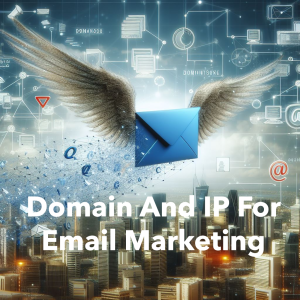Essential Steps to Optimize Your Domain and IP Address for Effective Email Marketing Campaigns
Email marketing is fundamental for businesses seeking to establish robust communication with potential and existing customers. This time-tested strategy allows for direct engagement, helping brands foster relationships and drive conversions. However, to maximize the impact of your email outreach, it’s crucial to ensure that your campaigns reach a broad audience. Implementing a domain and IP warmup strategy is vital, especially if you plan to send marketing communications from a newly created domain or IP address, ensuring that your messages are delivered to your subscribers’ inboxes rather than being lost in spam filters.
It is essential to take the necessary precautions during this process. By warming up your sending domain and IP address, you can help ensure that your email marketing campaigns are delivered and engaged with by your target audience.
A thorough domain and IP warmup will be beneficial if you want to send your marketing campaigns from a fresh domain or IP address and ensure that your subscribers see them.
Understanding the Importance of Domain and IP Warmup in Email Marketing
Domain and IP warmup is the methodical process of incrementally increasing your email sending volume over several weeks. This strategy is designed to establish a strong and positive sending reputation for your new domain, allowing it to become fully “warmed up” and prepared for the larger volumes required for effective email marketing campaigns while minimizing the risk of being caught by spam filters.
It’s crucial to start with a modest number of emails and gradually increase the sending volume. A typical warmup schedule might involve starting with just ten emails per day during the first week, followed by a systematic increase over the next 4-6 weeks. Maintaining consistency in the number of emails sent and the timing of your outreach is key to fostering a positive reputation with email service providers.
Deviating from this gradual approach can result in spam filters flagging your messages, so adjusting your sending volume appropriately while adhering to this progressive strategy is essential.
The Critical Role of Domain and IP Warmup in Successful Email Campaigns
Every day, approximately 14.5 billion emails are flagged as spam globally, which accounts for nearly half of all emails sent. This highlights the reality that many messages never reach their intended recipients due to spam filters. For businesses that rely on sending large volumes of emails to their subscribers, the last thing you want is for your communications to be flagged as spam by email service providers.
Ensuring successful email deliverability has intensified over time as significant email providers have significantly enhanced their spam detection capabilities, resulting in stricter filtering mechanisms. Suppose emails originate from a new or “cold” sending domain or IP address. In that case, they are much more likely to be rejected or filtered into spam folders, meaning your carefully crafted messages never reach the users.
This occurs because Internet Service Providers (ISPs) and email companies, such as Microsoft, Yahoo!, Gmail, and Outlook, are inherently wary of new domains and IP addresses that lack a proven sending history. By gradually warming up your domain and IP address, you build a favourable sending reputation, allowing email service providers to trust your communications over time.
Identifying When Domain and IP Warmup is Necessary for Email Marketing
If you have recently registered a new domain name or acquired a dedicated IP address for your email services, warming both is essential to ensure optimal email deliverability, as they are considered “cold” at this stage. However, there are other scenarios in which warming is also required.
For instance, if you receive a new IP address—perhaps due to changing email hosting providers or being assigned a new dedicated IP—while your sending domain remains the same, you may still encounter deliverability issues during your outreach efforts. It’s important to note that warmups are only necessary for dedicated IP addresses. If you use a service that employs shared hosting, such as Namecheap Private Email, the IP addresses are typically already warmed up; your focus should be on ensuring your domain is warmed up effectively.
Alternatively, if you link a newly registered domain to an existing IP address, be wary. Email service providers treat new domains with greater scrutiny than new IP addresses, so warming up those domains is critical.
Configuring Your Email Account for Marketing Success
The first step in your email marketing journey is to obtain a reliable email service—such as Namecheap Private Email or Shared Hosting—and set up your mailbox. After securing your service, ensure your email domain’s DNS settings are correctly configured to facilitate seamless operation.
Additionally, it’s crucial to configure SPF, DKIM, and MX records, which are essential for the proper functioning of email services. These systems work as email authentication protocols to prevent spoofing and phishing attempts, enhancing your overall email security. Mail servers utilize these DNS entries to verify the authenticity of incoming emails, which is increasingly vital.
As of 2023, many email service providers will outright reject emails sent from domains lacking these configurations or those that are not set up correctly. Therefore, it’s imperative to thoroughly double-check all settings before initiating your email marketing campaigns.
Consequences of Missing SPF, DKIM, or DMARC Records
You may face several significant issues if your outgoing emails are not configured with SPF, DKIM, or DMARC records. First and foremost, your emails may be directed to spam or junk folders, preventing them from reaching your intended audience.
Additionally, you might find that outgoing emails are not being delivered to the target server, leading to bounce-back notifications that indicate a high probability of spam. This situation arises because criminals often attempt to spoof emails on behalf of your domain, posing significant risks to your brand’s reputation.
Email spoofing involves falsifying an email address to create the illusion that the message is legitimate, which can deceive recipients into opening potentially harmful content. Therefore, ensuring that your SPF, DKIM, and DMARC records are properly set up is crucial to maintaining email security and deliverability.
Enhancing Your Email’s Credibility Through Personalization
Personalizing your email address by incorporating your name and a professional signature is vital to making your emails appear more authentic and relatable to recipients. For optimal effectiveness, your email signature should include essential information such as your name, job title, company name, physical address, phone number, email address, and website.
You may also add a signature that includes your photo or your company’s logo, further enhancing your brand’s credibility. However, be cautious; if the HTML in your footer is overly complicated and takes up more space than the body of your message, it may trigger anti-spam filters, leading to your emails being rejected.
Tip: When creating your email account, ensure your email address is associated with a legitimate website to enhance its credibility. The exact website linked to your account can be modified later if necessary, so focus on establishing that initial connection.
Assessing the Age of Your Domain for Email Deliverability
As previously mentioned, spam filters often flag newly registered domains as suspicious due to their criteria for assessing domain age. If a domain is less than 30 days old, it will likely be automatically reported as a potential spam source.
This precaution is primarily in place to protect users from receiving spam or malicious emails from senders who frequently shift between new domains to evade detection. Spammers typically send large volumes of emails from unknown IP addresses, adhering to a pattern of purchasing new domains or email plans and rapidly sending out spam until the provider blocks their new address.
Consequently, emails sent from these newly registered domains are viewed with scepticism, which can lead to significant deliverability issues. To mitigate these risks, you must wait at least thirty days before commencing your warmup process.
Crafting High-Quality Content to Boost Engagement
Compose relevant and high-quality content in your emails to enhance consumer engagement. If your content appears spammy or irrelevant, recipients are less likely to click on promotional links, diminishing the chances of future email opens. Several strategies can elevate the quality of your email content.
Readability: Adjust the length of your email content to align with its purpose. For instance, sales emails or lead-generating communications should be concise, as readers typically prefer brevity, especially when confronted with product promotions or discounts.
Conversely, newsletters and more informative emails can afford to be longer. Always prioritize clarity by using short, straightforward sentences, breaking content into small paragraphs, and selecting a legible font that is easy for users to skim.
Avoiding Spam Patterns: Write in a natural, human-like tone, removing generic placeholder text such as “lorem ipsum” and avoiding common spam triggers. It’s also wise to avoid excessive formatting like all caps (e.g., OPEN), unnecessary spacing between letters (e.g., O P E N), or excessive punctuation, as these will likely raise red flags.
Specific symbols such as !!!, $$$, and phrases like “100% free” can trigger spam filters, so always ensure your topics are meaningful and relevant.
Personalization: Tailor your email copy to resonate with the recipient. Incorporating their name or offering personalized suggestions can increase reader interest and motivate them to engage with your content.
Mobile Optimization: Since 75% of customers check emails on their mobile devices, it is crucial to ensure that your emails are optimized for all platforms. This includes using responsive layouts, appropriate font sizes, and images that display well on smaller screens.
Initiating Your Email Campaigns with Manual Sending
Once you have configured your email account and DNS records and prepared your content, you can manually send emails from your new account. Here are some key points to focus on during this phase:
Prioritize Recipient Quality
The quality of your email recipients is crucial during this initial phase. It’s advisable to only send emails to your familiar addresses, such as your own or those of individuals likely to engage, including friends, family, and colleagues. To diversify your outreach and improve engagement, aim to distribute emails across various email providers, including AOL, Yahoo, Yandex, Gmail, and Outlook.
Encourage Genuine Responses
After sending your emails, encourage recipients to respond to your messages. This feedback is vital for establishing the authenticity of your communications in the eyes of email providers. Maintaining a genuine tone in your replies is essential; respond to recipients as you would in any standard correspondence to avoid appearing overly promotional.
If your emails have been misclassified as spam or junk by the recipient’s email provider, kindly ask them to mark your message as “not spam” and move it to their inbox. This action can help improve your sender’s reputation and deliverability rates.
Maintaining Controlled Volumes
As emphasized earlier, starting slowly and progressively increasing the volume of your email sends is crucial during the warmup phase. Begin by sending a maximum of 10 emails daily, then gradually increase this figure. Consistency in your sending volume and schedule is paramount; excessive volumes too quickly may trigger anti-spam filters. A potential warmup schedule could look like this:
Week 1: ten emails.
Week 2: 30 emails.
Week 3: 80 emails.
Week 4: 100 emails.
Week 5: 150 emails.
Week 6: 200 emails.
Remember that this is only a suggested timeline, and you may need to adjust it based on your circumstances.
Understanding Your Sending Limits:
Each email service provider limits the number of emails users can send daily. Familiarizing yourself with these restrictions will help ensure your account remains in good standing and that your warmup process is effective.
The post Set Up Your Domain And IP For Email Marketing appeared first on Ezi Gold.
The Article Set Up Your Domain And IP For Email Marketing Was Found On https://limitsofstrategy.com




I really appreciate how you highlighted the importance of warming up a domain and IP address before diving into email marketing campaigns. It’s a step that I think many newcomers overlook, especially when they’re excited and eager to launch their first campaigns.
Warming up a domain and IP address is one of those crucial steps that can really set the tone for a campaign. Many newcomers get caught up in the excitement of crafting the perfect email without realizing that jumping in too quickly might lead to frustrating outcomes, like being flagged as spam. It’s like building a house on a shaky foundation; no matter how beautiful the design is, it risks collapsing.